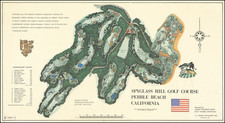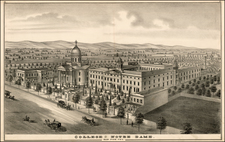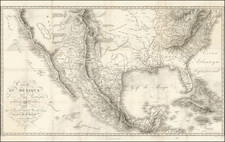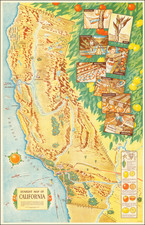Rare series of six cross-sectional drawings of geological formations in the Iowa Hill Mining District of Placer County, intended to illustrate the underground structures and mineral deposits, such as gold-bearing channels, within the hills of this mining area.
Published in Sacramento by the California State Mining Bureau, the map identifies J.B. Hobson, assistant in the field, as the creator of the image.
The Iowa Hill Mining District is located in Placer County, California. In 1853, miners prospecting the North Fork of the American River discovered gold along the north flank of a ridge between the North Fork of the American River and Indian Canyon. The miners made camp atop the ridge and christened it Iowa Hill and from then on, the ridge became known as the Iowa Hill Divide. Further prospecting revealed that the rich Tertiary gravel deposits were perched above the American River on the flanks and underlying the divide. The camp grew around the Jamison claim, which was first drift mined and later hydraulically mined.
First named "Iowa City", the post office was first opened in 1854. By 1856, the production value of the mines exceeded $100,000. By 1880, the production value was up to $20 million.
During the first few year's drift mining prevailed, with many miles of drifts being driven under the divide to exploit the rich blue lead gravel. The North Star Mine was the first in the state to use a stamp mill to crush the hard cemented basal blue-lead gravels. When these gravels began to play out, attention turned to hydraulic mining of the finer gravels along the flanks of the divide.
The introduction of water by the Iowa Hill Canal rendered the working of large tracts of land quite profitable. In 1875, there was enough traffic to support two daily lines of stages connecting with the railroad at Colfax.
The region would become one of the significant hydraulic mining areas in the state. Some of the short-lived camps in the area included Independence Hill, Roach Hill, Bird’s Flat, Stephen’s Hill, Elizabethtown, Wisconsin Hill, Grizzly Flat at Grizzly Canyon, and Montana Flat. Drift mining continued through the early 1900s, and there was appreciable activity again in the 1930s. Most of the town was destroyed by fire in 1922.
Hydraulic mining, which became prevalent in the 1850s and 1860s, was a form of mining that used high-pressure jets of water to dislodge rock material or move sediment. In the placer mining method, these high-pressure water cannons could wash away entire mountainsides, which would then be run through sluices to extract the gold.
The cross-section plates accompanying the geological map of the Iowa Hill Mining District would have been essential for the miners and geologists of the time. These drawings provided detailed insights into the geological strata of the area, including ancient river channels that were often rich with gold deposits, known as 'blue' and 'white' gravel channels due to the color of the gravel they contained. These channels, once riverbeds, had been buried and preserved under volcanic material, known as 'volcanic cappings' in the reference key, and were sought after for the potential wealth they contained.
The method of hydraulic mining, illustrated in these plates by the presence of various channels and diggings, was later restricted by the federal government with the passage of the Sawyer Decision in 1884 due to the massive environmental degradation it caused.
The Iowa Hill district was known for its rich deposits and was one of the most productive in the state. However, the nature of its hydraulic mining operations meant that the landscape underwent a dramatic transformation, with hillsides washed away and valleys filled with debris. These cross-sections serve not only as technical documents for mining operations, but also as historical records of the extensive impact human activity had on California's natural landscape during the Gold Rush.
Rarity
This is one of 3 separately published maps and diagrams to accompany the 10th Report of the California State Mining Bureau.
OCLC locates 4 examples (Yale, University of Chicago, UC Berkeley, UC Riverside).











![[ Alaska / Cabo San Lucas / San Blas / Chile ] Views of Headlands and Islands on the Coasts of North West and South America](https://storage.googleapis.com/raremaps/img/small/88077.jpg)


![(Germans in California) [Manuscript journal kept by Pastor J. K. Nagel recording names and details of German residents of Santa Rosa, Visalia, Fresno; Sonoma and Tulare Counties; San Joaquin Valley] Diarium Pastorale. Hilfs-und Schreibbuch für Geistliche](https://storage.googleapis.com/raremaps/img/small/97633.jpg)